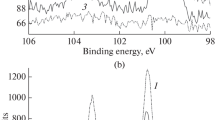Abstract
Using glancing-angle ion bombardment for surface modification rather than conventional near-normal incidence ions has the advantages of reducing damage and implantation projected ranges, reducing channeling, reducing sputtering, and preferentially removing surface asperities leading to flat surfaces. The effects of bombardment conditions on the surface morphology and perfection of GaAs (001), InP (001), and Si (001) surfaces are reported. Air-exposed surfaces were cleaned and smoothened to near atomic flatness without damage under optimal conditions. Sputtering yield, measured using film thicknesses and changes in reflection high-energy electron diffraction oscillations, decreased with decreasing incidence angle. The low sputtering yield and minimal damage make a glancing-angle geometry ideal for real-time characterization by ion scattering spectroscopy. Surface composition measurements on single monolayers of InAs on GaAs showed that the glancing-angle Ar beam did not measurably change the In coverage over relatively long times. A new ion beam monitoring technique was also developed that utilizes the advantages of glancing-angle ions. Specular scattering of 3 keV He ions was observed for incidence angles of 2–6° from GaAs (001). Oscillation in the specularly scattered ion current during GaAs growth were observed with periods corresponding to monolayer growth times. The oscillations allow a simple quantitative interpretation based on scattering by adatoms and step edges.
Similar content being viewed by others
References
E. Chason and T.M. Mayer, Appl. Phys. Lett. 62, 363 (1993).
E.A. Eklund, R. Bruinsma and J. Rudnick, Phys. Rev. Lett. 67, 1759 (1991).
D.G. Armour and A.H. Al-Bayati, Nucl. Instrum. Methods Phys. Res. B 67, 279 (1992).
S.T. Picraux, D.K. Brice, K.M. Horn, J.Y. Tsao and E. Chason, Nucl. Instr. Meth. Phys. Res. B 48, 414 (1990).
J.C. Bean, G.E. Becker, P. M. Petroff and T. E. Seidel, J. Appl. Phys. 48, 907 (1977).
F.D. Auret, G. Myburg, S.A. Goodman, L.J. Bredell and W.O. Barnard, Nucl. Instr. Meth. Phys. Res. B 67, 410 (1992).
M.M. Sung, C. Kim and J.W. Rabalais, Nucl. Instr. and Meth. B 118, 522 (1996).
M. Katayama, E. Nomura, H. Soejima, S. Hayashi and M. Aono, Nucl. Instr. and Meth. B 45, 408 (1990).
R.E. Lee, J. Vac. Sci. Technol. 16, 387 (1978).
P. Oelhafen, J.L. Freeouf, G.D. Pettit and J.M. Woodall, J. Vac. Sci. Technol. B 1, 787 (1983).
I. Suemune, A. Kishimoto, K. Hamaoka, Y. Honda, Y. Kan and M. Yamanishi, Appl. Phys. Lett. 56, 2393 (1990).
R.A. Hoffman, W.J. Lange, A.J. Noreika and J.J. Schreurs, J. Vac. Sci. Technol. 20, 341 (1982).
S.B. Ogale, A. Madhokar and M. Thomsen, Appl. Phys. Lett. 51, 837 (1987).
J.G.C. Labanda and S.A. Barnett, J. Vac. Sci. Technol. A 14, 485 (1996).
J.G.C. Labanda, L. Hultman and S.A. Barnett, J. Vac. Sci. Technol. B13, 2260 (1995). See also J.G.C. Labanda, L. Hultman and S.A. Barnett, Appl. Phys. Lett. 63, 3114 (1995).
J.G.C. Labanda, L. Hultman and S.A. Barnett (unpublished).
J.E. Guyer, J.G.C. Labanda, M.R. Pillai, P. Deluca and S.A. Barnett (unpublished).
J.G.C. Labanda and S.A. Barnett, J. Vac. Sci. Technol. A 15, 825 (1997).
R.F. Kopf, J.M. Kuo and M. Ohring, J. Vac. Sci. Technol. B 9, 1920 (1991)
P. Bedrossian, J.E. Houston, J.Y. Tsao, E. Chason and S.T. Picraux, Phys. Rev. Lett. 67, 124 (1991).
E. Spiller, Appl. Phys. Lett. 54, 2293 (1989).
D.G. Schimmel, J. Electrochem. Soc. 123, 734 (1976).
H. Niehus, W. Heiland and E. Taglauer, Surf. Sci. Rep. 17, 213 (1993).
F. Honzay, C. Guille, J.M. Moison, P. Henoc and F. Barthe, J. Cryst. Growth 81, 67 (1987).
R. Kaspi and K.R. Evans, Appl. Phys. Lett. 67, 819 (1995).
J.G.C. Labanda and S.A. Barnett, Appl. Phys. Lett. 70, 2843 (1997).
Author information
Authors and Affiliations
Rights and permissions
About this article
Cite this article
Labanda, J.G.C., Barnett, S.A. Glancing-angle ion bombardment for modification and monitoring of semiconductor surfaces. J. Electron. Mater. 26, 1030–1038 (1997). https://doi.org/10.1007/s11664-997-0240-3
Received:
Revised:
Issue Date:
DOI: https://doi.org/10.1007/s11664-997-0240-3




